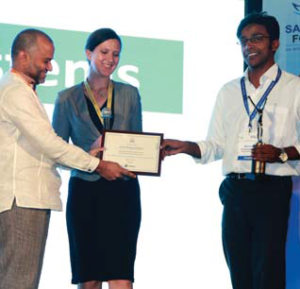
Green Power Systems (GPS Renewables Private Limited or simply GPS), was a cleantech company based in Bangalore, co-founded by Mainak Chakraborty and Sreekrishna Sankar (Sankar) in late 2010. They were both MBA graduates from IIM Bangalore, who were working in the corporate sector.
Chakraborty was aware of the worsening situation across India on bio-waste treatment because of lack of space, improper reutilization and poor maintenance of the existing technology models. However, he knew about successful bio-waste energy management practices in the western world and how companies have been successful in turning bio-waste into energy.
Thus, along with his MBA senior Sankar he conducted a study across the country and found the urban centres to generate major amount of food waste from a very small percentage of the population/area such as
restaurants, hotels, corporate kitchens, schools and colleges. Given that one of biggest cost-heads for such establishments was commercial cooking fuel, it made a lot of sense to convert the waste into energy locally.
However, Chakraborty and Sankar also found that the general opinion about bio-gas was negative because of
many shortcomings, such as: need for dedicated piece of land with civil works, significant water requirements, difficult maintenance and a messy repair/recovery method in case of breakdowns.
Both Chakraborty and Sankar realized that there was a need for a compact biowaste-to-energy reactor that would be designed keeping in mind the budget, space and other constraints of private and institutional clients. The idea was to build a for-profit firm but with a social and environmental impact. Thus, the two set up GPS in
2010. However, having found the gap, filling it was not an easy job.
Chakraborty said: “India has a lot of quality information technology (IT) engineers. However, we needed mechanical and electrical engineers who had the power of innovation. This was not easy.” Subsequently, they came up with a design of a compact bio-waste reactor that was prefabricated and could be assembled at the clients place with little effort.
The major innovation though was in the technology support since it was an IT- based cloud support mechanism which required very little human intervention for monitoring unlike traditional bio-gas plants. The first prototype was given shapein 2011.
Akshaya Patra
The next challenge was to convince the target audience as Chakrabarty found out that there was a lot of
negative affect towards bio-gas solutions. Thus, the first round of convincing led GPS to Akshaya Patra, a Bangalore based NGO who allowed GPS to run the product at their site on a trial basis by late 2012. GPS had broken the ice.
After a year of commercial pilot experience at Akshaya Patra, GPS started commercialization of their product
named BioUrja that had received lukewarm response from its potential customers by late 2013. Some of the
top brass at Akshaya Patra were also associated with Infosys, a leading IT company in India. When they saw
the product and its functionality, they were interested and GPS got the contract to install and run similar
plants at Infosys offices across India.
By 2014, GPS was able to gain a foothold by installing its plants at many institutions and organizations in India. The company was also successful in receiving seed money from the Government of India and various accolades that provided publicity to the company.
However, there were two major challenges that the company was facing in 2014. The first was the issue of scaling up operations. The company was founded at a low financial base and being a non-stylized venture unlike online retail or technology ventures, it was not attractive to funding institutions. The other challenge was that of consumer awareness was low.
Majority equated BioUrja with a traditional biogas plant and thus were sceptical about its efficiency. To move ahead, GPS had to tackle both these issues. How did they do that?









